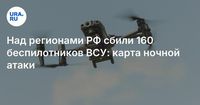In a dramatic escalation of hostilities, the Ministry of Defense of Russia reported that air defense systems successfully intercepted and destroyed a staggering 158 Ukrainian drones during a massive attack on April 8 and 9, 2025. This latest assault marks one of the most significant UAV (unmanned aerial vehicle) offensives against Russian territories since the onset of the ongoing conflict.
The aerial onslaught unfolded between 8:00 PM Moscow time on April 8 and 6:00 AM on April 9, with the bulk of the drones being shot down over various regions. The Krasnodar Territory bore the brunt of the attack, where air defense forces managed to down 67 drones. Additionally, 29 UAVs were intercepted over the Rostov Region, 15 over North Ossetia, 11 over Voronezh, and 10 over Kursk. The Sea of Azov and the Black Sea also saw action, with seven and six drones respectively being destroyed in those waters.
In total, the air defense operations extended across ten regions, showcasing the extensive reach and capability of Russia's military response to aerial threats. Notably, five drones were neutralized over the Belgorod Region, three in Crimea, two in Penza, and one each in Saratov, Orel, and Stavropol. Fortunately, the Tver Region reported no disturbances during this time.
The Ministry of Defense's announcement came as authorities lifted restrictions on air traffic at several key airports. At 7:05 AM Moscow time, the airports of Vladikavkaz (Beslan), Grozny (Severny), and Volgograd (Gumrak) resumed normal operations after being temporarily closed due to the threat posed by the drone attacks. A representative from Rosaviatsia confirmed that three aircraft had been redirected to alternate airfields during the restrictions, which had been imposed earlier due to the UAV threat.
"From 1:53 AM Moscow time, the airports of Vladikavkaz and Grozny ceased accepting and dispatching aircraft, with similar measures enforced at Volgograd starting at 7:26 PM the previous evening," the representative explained. This swift action underscores the serious nature of the threat posed by the drone incursions.
The recent attack aligns with ongoing tensions between Russia and Ukraine, as both nations continue to engage in military operations. The use of drones has become a pivotal aspect of modern warfare, and this incident highlights the escalating reliance on UAV technology in the conflict. As military strategies evolve, both sides are increasingly employing drones for surveillance and offensive operations.
In light of the current situation, the Russian government has urged citizens to remain vigilant. Residents in the Tver Region, for instance, have been reminded to report any sightings of UAVs immediately. The anti-terrorism commission has developed a protocol for citizens and organizations to follow in such instances, emphasizing the importance of community awareness and cooperation.
"If you spot a drone, please report it to the emergency services by calling '112' or the local police at '102,'" officials advised. This proactive approach aims to enhance public safety and mitigate potential threats from UAVs.
The implications of this drone attack are significant, not only for military strategy but also for civilian life in the affected regions. The swift response by air defense forces is a testament to the preparedness and capability of the Russian military, yet it also serves as a stark reminder of the ongoing conflict's impact on everyday life.
As tensions continue to simmer, the international community watches closely. The use of drones in warfare raises questions about the future of military engagements and the potential for further escalation. With both sides demonstrating a willingness to utilize advanced technology, the landscape of the conflict is rapidly changing.
Experts suggest that the increasing frequency of drone attacks could lead to a reevaluation of defense strategies on both sides. This could involve not only improvements in interception technology but also a broader discussion on the rules of engagement in modern warfare.
In conclusion, the recent surge in drone activity highlights the ongoing volatility in the region and the significant challenges faced by both military forces and civilians. As Russia continues to bolster its air defense capabilities, the situation remains precarious, with the potential for further confrontations looming on the horizon.






